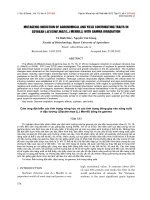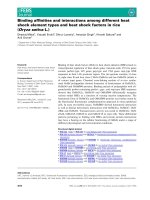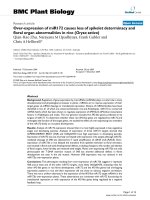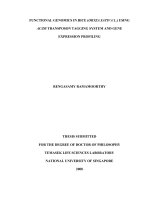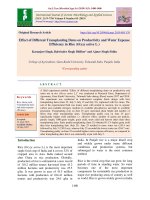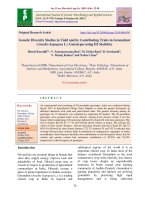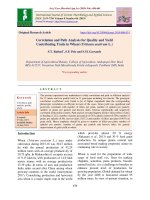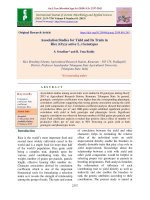Genetic parameters study for yield and yield contributing characters in rice (Oryza sativa L.) genotypes with high grain zinc content
Bạn đang xem bản rút gọn của tài liệu. Xem và tải ngay bản đầy đủ của tài liệu tại đây (242.46 KB, 8 trang )
Int.J.Curr.Microbiol.App.Sci (2020) 9(3): 357-364
International Journal of Current Microbiology and Applied Sciences
ISSN: 2319-7706 Volume 9 Number 3 (2020)
Journal homepage:
Original Research Article
/>
Genetic Parameters Study for Yield and Yield Contributing Characters in
Rice (Oryza sativa L.) Genotypes with High Grain Zinc Content
Partha Pratim Behera1*, S. K. Singh1, D. K. Singh1 and Khonang Longkho2
1
Department of Genetics and Plant Breeding, Banaras Hindu University,
Varanasi- 221 005, India
2
Department of Genetics and Plant Breeding, Visva Bharat, West Bengal, India
*Corresponding author
ABSTRACT
Keywords
Genetic variability,
GCV, PCV,
Heritability,
Genetic advance,
Analysis of
variance
Article Info
Accepted:
05 February 2020
Available Online:
10 March 2020
The present investigation for genetic variability was made based on the data
recorded for sixteen yield and yield contributing quantitative and
qualitative characters in twenty one rice genotypes using statistical
tool.There are significant differences among the genotypes for all the
characters under study showed by analysis of variance. Among the
characters, higher estimates of phenotypic coefficient of variance (PCV)
and genotypic coefficient of variance (GCV) were observed for the traits
number of spikelet per panicle, no of filled grains per panicle, grain weight
per panicle(g) and grain yield/ha (kg). This indicates the existence of wide
genetic base among the genotypes taken for study and higher possibility of
genetic improvement through selection for these traits. Heritability was
higher for all the characters except tillers per plant, spikelet fertility per
cent and panicle length (cm). Thus, selection based on phenotypic values
would be effective for these traits. High heritability coupled with high
genetic advance as per cent of mean was recorded for the characters; days
to first flowering, days to 50 per cent flowering, number of filled grains per
panicle, number of spikelet per panicle, grain yield per plot (kg), grain
weight per panicle (g), grain yield per plant (g), 1000 grains weight (g),
grain zinc content (ppm) and grain yield/ha (kg). These characters indicate
the predominance of additive gene effects in their expression and would
respond to selection effectively as they are least influenced by environment
which can be improved through simple selection.
357
Int.J.Curr.Microbiol.App.Sci (2020) 9(3): 357-364
environment for the traits. An estimate of
heritability and genetic advance for different
characters ultimately provides an appropriate
guideline for selection and also the expected
genetic gain. A quantitative measure which
delivers
information
about
the
correspondence between genotypic variance
and phenotypic variance is heritability.
Achievement of a breeder in changing the
characteristics of a population is subjected to
heritability that is, the degree of
correspondence between genotypic and
phenotypic variance. Heritable improvement
in yield is the ultimate object of plant breeder
which calls for selection on the basis of yield
components which are heritable. It becomes
very important for breeders to go for selection
of elite genotype from diverse population
which helped by estimates of heritability.
However, high heritability estimates coupled
with high genetic advance render the selection
most effective (Johnson et al., 1955).
Introduction
Rice (Oryza sativa L.) is a short day
monocotyledonous self-pollinated angiosperm
within the genus Oryza of family Poaceae. It
is the principal nourishment for 33% of the
total population and involves very closely
one-fifth of the aggregate land territory
occupied under cereals (Ren et al., 2006). ).
Rice is produced in 114 countries across the
globe estimating production of 753mt (499mt
milled rice, 2016) and forecasting 758mt
(503.6mt milled rice, 2017) with world rice
acreage of 161.1 mha (FAO, 2017). Among
the rice growing countries in the world, India
occupied the largest area under rice crop
(about 45 million ha.) having the second
position in production next to China, (IRRI
2016, standard evaluation system for rice.).
As world’s population is growing in
exponential rate and maintain the food
security as per the need is a challenging task
for us as it is faced by so many constraints
due to climate change. Variability is a vital
factor which determines the amount of
progress expected from selection. As
phenotypic variation does not directly show
its effectiveness for selection to obtain genetic
improvement unless the genetic fraction of
variation is known. Hence, an insight into the
magnitude of genetic variability available is
of paramount importance to a plant breeder
for starting a prudent breeding programme. It
becomes necessary to partition the phenotypic
variability into heritable and non-heritable
components with the help of genetic
parameters such as genotypic and phenotypic
co-efficient, heritability and genetic advance
to facilitate selection. The variances were
expressed as coefficient of variation so as to
facilitate their comparison amongst different
characters. The phenotypic co-efficient of
variation was in general, higher than the
genotypic co-efficient of variation. But the
differences between PCV and GCV for many
traits were less, suggesting the less impact of
Materials and Methods
This experiment was conducted to study the
genetic variability for yield and yield
contributing traits among twenty-one diverse
rice genotypes with high grain Zinc content
collected from IRRI South Asia Hub,
Hyderabad (Table.1) over five different
locations i.e. (I) Agricultural Research Farm,
Institute of Agricultural Sciences, Banaras
Hindu
University,
Varanasi,
UP,(II)
Agricultural Research Farm, Institute of
Agricultural Sciences, Banaras Hindu
University, Varanasi, UP (III) Bhikaripur,
Varanasi, UP (IV) Karsada, Varanasi, UP (V)
Rampur, Mirzapur, UP during Kharif 2017.
Net Plot size was 2.4 m×2.4m, twelve rows
were grown having inter and intra row
spacing was 20cm and 15cm respectively for
each location under study. They were grown
in a randomized block design with three
replications and observations were recorded
on randomly selected five plants for the
358
Int.J.Curr.Microbiol.App.Sci (2020) 9(3): 357-364
sixteen quantitative and qualitative traits i.e
days to first flowering, days to 50%
flowering, days to maturity, number of
effective tillers per plant, plant height (cm),
panicle length (cm), number of spikelet per
panicle, number of filled grains per panicle,
spikelet fertility per cent, grain weight per
panicle (g) , grain yield per plant (g), 1000grain weight (g), Grain yield per plot (kg),
Grain yield per ha (kg), L/B ratio, and grain
zinc content(mg/kg) were considered. Zinc
content of rice grains was estimated in the
aliquot of seed extract by using Atomic
Absorption Spectrophotometer (AAS) at
213.86 nm for Zinc. The genotypic and
phenotypic variances, genotypic (GCV) and
phenotypic (PCV) coefficient of variation
were estimated according to formula given by
Burton (1952). Heritability in broad sense [h2
(b)] was estimated according to formula given
by Lush (1940) and genetic advance and
Genetic advance as per cent of mean were
estimated as formula suggested by Johnson et
al., (1955) by using suitable statistical tool.
grain weight per panicle and number of filled
grains per panicle. Mahto et al., (2003),
Satyanarayana et al., (2005) and Singh et al.,
(2007) also reported similar findings in
upland rice for the grains per panicle.
Moderate estimates of PCV and GCV were
observed for the traits, days to first flowering
(10.67%, 10.58%), number of effective tillers
per plant (17.45%, 12.40%), 1000 grain
weight(g) (16.71%, 15.62%) and grain zinc
content (ppm) (18.08%, 15.5%) respectively.
This suggests that the genetic improvement
through selection for these traits may not be
always effective. Similar results were also
obtained by Dhurai et al., (2014) and
Dhanwani et al., (2013) in rice reported for
panicle length and other yield attributes. Low
estimates of PCV and GCV were observed
respectively for the characters days to 50%
flowering (10.05%, 9.99%), days to maturity
(8.41%, 8.36%) and spikelet fertility percent
(7.95%, 5.26%), pant height (8.94%, 7.26%),
panicle length (8.61%, 6.55%) and LB ratio
(9.37%, 8.73%) suggesting that the direct
selection for these traits may not be
rewarding. The similar results were also
reported by Kaw et al., (1995), Muthuramu et
al., (2016) for days to maturity in cold stress
environment. The estimate of heritability
ranged from 46.4% (spikelet fertility percent)
to 98.8% (Days to 50 % Flowering).
Percentage of heritability was higher for all
the characters except spikelet fertility percent
(46.4%), panicle length (58.16%) and number
of effective tillers per Plant (50.41%) (Table
3), similar study conducted by Satyanarayana
et al., (2005) in rice for panicle lengths and
number of effective tillers per plant found to
be not effective for selection due to low
heritability. Thus, selection based on
phenotypic values would be effective for
these traits. These findings are in agreement
with those of Kundu et al., (2008) for number
of filled grains per panicle and 1000-grain
weight in tall indicaaman rice and Kole and
Hasib (2008) for plant height, days to 50%
Results and Discussion
Based on the Pooled analysis of variance
(ANOVA) (Table 2) revealed that there is
significant variation exists among the twenty
one genotypes for all the sixteen characters
over the five locations which will favourable
for efficient selection. Among the characters,
higher estimates of PCV and GCV were
observed respectively for the traits, number of
spikelet
per
panicle
(PCV=32.85%,
GCV=29.99%), number of filled grains per
panicle (32.19%, 29.07%) and grain weight
per panicle(g) (30.66%, 27.01%) (Table 3).
This indicates the existence of wide genetic
base among the genotypes taken for study and
possibility of genetic improvement through
selection for these traits. This was in
conformity with the findings of Reddy De et
al., (1998) who reported higher PCV and
GCV in rice for no of spikelet per panicle,
359
Int.J.Curr.Microbiol.App.Sci (2020) 9(3): 357-364
flowering, panicle length, kernel length and
kernel L/B ratio in scented rice. In the present
study most of the characters recorded high
heritability estimates and selection would be
effective if based on phenotypic values. High
heritability coupled with high genetic advance
as per cent of mean was recorded respectively
for the characters, days to first flowering
[h2(broad sense)=98.34% and GA(% per
mean) =21.62%], days to 50% percent
flowering (98.8%, 20.46%), spikeletper
panicle (83.38%, 56.44%), filled grains per
panicle (81.48%, 54.13%), grain weight per
panicle(g) (77.66%, 49.05%), grain yield per
plant (g) (64.57%, 30.35%), grain yield per
plot (kg) (64.52%, 30.33%), grain zinc
content(mg/kg) (75.67%, 27.73%) and
yield/ha rainfed (kg) (64.59%, 30.35%)
(Table.3). These results are similar with the
results obtained by Gyanendrapal et al.,
(2011) for grain yield per plant, spikelet per
panicle, effective tillers per plant and days to
50% flowering, Krishna et al., (2010) for
number of total spikelets per panicle and
number of filled grains per panicle,
Anjaneyulu et al., (2010), Bhinda et al.,
(2017) for number of filled grains per panicle,
Kundu et al., (2008) for grain yield per plant
and 1000-grain weight in tall indicaaman rice
and Singh et al., (2007) for days to 50%
flowering and grains per panicle. These
characters indicate the predominance of
additive gene effects in their expression and
would respond to selection effectively as they
are least influenced by environment.
Table.1 List of 21 genotypes collected from IRRI South Asia Hub, Hyderabad
SL.N
o
Name of Genotype
1
IR 95044:8-B-5-2219-GBS
IR 84847-RIL 1951-1-1-1
IR 99704-24-2-1
IR 99647-109-1-1
IR 97443-11-2-1-11-1 -B
IR 97443-11-2-1-11-3 -B
IR 82475-110-2-21-2
20.6
12
BRRIdhan 64
Grain Zinc
Content
(ppm)
24.97
21.8
13
BRRIdhan 72
20.7
14.67
23.7
14.45
14
15
16
DRR Dhan 45
DRR Dhan 48
DRR Dhan 49
18.13
19.2
17.63
23.47
17
IR 64
23.57
24.73
18
IR 96248-16-3-3-2B
R-RHZ7
CGZR-1
27.18
2
3
4
5
6
7
8
9
10
11
BRRIdhan 62
Grain Zinc
SL.No Name of Genotype
Content (ppm)
21.70
19
MTU101
0
Sambamahsuri
24.47
26.61
20
Swarna
18.89
24.43
21
Local
check
16.9
23.33
360
Int.J.Curr.Microbiol.App.Sci (2020) 9(3): 357-364
Table.2 Pooled ANOVA of twenty one rice genotypes for sixteen characters over the five different locations
Entry
No
Days to
1st
flowering
Days to
50 %
Flowering
Days to
Maturity
Tillers
Per
Plant
Plant
Height
(cm)
Panicle
Length
(cm)
Spikelets
Per
Panicle
Filled
grains
Per
Panicle
Spikelet s
Fertility%
Grain
Weight
Per
Panicle
(g)
Grain
Yield
Per
Plant
(g)
1000grain
Weight
(g)
Grain
Yield
Per
Plot
(kg)
Grain
Yield/ha
(kg)
L/B
Ratio
Grain
Zinc
content
(ppm)
Mean
93.746
98.181
126.800
7.873
106.7
26.013
109.300
83.121
76.374
1.507
11.618
18.258
0.941
3920.880
4.000
22.158
C.V.
1.361
1.094
0.932
12.206
5.000
5.551
13.281
13.684
5.818
14.420
13.086
5.844
13.106
13.086
3.288
8.476
F ratio
186.887
253.998
249.311
4.185
9.848
5.434
17.245
15.323
4.230
12.128
7.114
24.481
7.092
7.116
27.359
24.727
F Prob.
0.00E+00
0
0
0
0
0
0
0
0
0
0
0
0
0
0
0
S.E.
1.036
0.872
0.960
0.784
4.321
1.175
11.923
9.307
3.647
0.173
1.168
0.864
0.095
394.053
0.107
1.470
C.D.
5%
2.094
1.763
1.939
1.584
8.732
2.374
24.098
18.810
7.370
0.350
2.360
1.745
0.191
796.415
0.217
2.971
C.D.
1%
2.802
2.359
2.595
2.120
11.685
3.177
32.246
25.171
9.863
0.468
3.158
2.335
0.256
1065.700
0.290
3.976
Range
Lowest
80.267
85.000
111.800
6.06
98.43
23.41
70.4
54.13
71.6
1.023
8.97
13.82
0.726
3027.49
3.2
16.64
Range
Highest
114.800
119.000
148.333
9.733
128.08
30.30
185
136.6
81.67
2.182
14.57
21.76
1.18
4919.43
4.45
26.64
361
Int.J.Curr.Microbiol.App.Sci (2020) 9(3): 357-364
Table.3 Heritability (broad-sense), GCV, PCV and Genetic advance as per cent of mean of twenty one rice genotypes for sixteen
characters over the five different locations
Days to Days to 50 Days to Effective
first
%
Maturity Tillers
flowering Flowering
Per Plant
Plant
Height
(cm)
Panicle Spikelets Filled Spikelets
Grain
Grain 1000-grain Grain Yield/ ha L/B Grain Zinc
Length Per Paniclegrains Per Fertility % Weight Per Yield Per Weight (g) Yield Per (kg)
Ratio content
(cm)
Panicle
Panicle(g) Plant (g)
Plot (kg)
(ppm)
Var Environmental
1.63746
1.155397
1.405397
0.9254
29.7057
2.08942
233.6224
139.858
21.66341
0.0484183
2.157278
1.128295
0.01418
245718
0.018
3.987831
ECV
1.360573
1.09444
0.932205
12.2055
5.000082
5.55101
13.28061
13.6836
5.818053
14.420084
13.08637
5.843566
13.1052
13.086
3.288
8.476248
VarGenotypical
98.11333
95.99508
112.4733
1.00349
61.52866
2.96129
1127.157
590.055
16.85615
0.1685124
3.80825
8.531916
0.02499
433942
0.123
12.0755
GCV
10.58295
9.994176
8.364306
12.4047
7.265034
6.55156
29.99571
29.0729
5.266001
27.01118
18.13647
15.62485
18.1344
18.14
8.73
15.50079
VarPhenotypical
99.75079
97.15048
113.8787
1.92889
91.23436
5.05071
1360.78
729.913
38.51956
0.2169307
5.965528
9.660211
0.03917
679661
0.141
16.06333
PCV
10.67104
10.05414
8.416493
17.451
8.945215
8.61475
32.85638
32.1909
7.957148
30.663744
22.5036
16.71846
22.5114
22.506
9.371
18.08228
h² (Broad Sense)
0.983438
0.988084
0.987613
0.50414
0.669151
0.5816
0.833896
0.81481
0.464045
0.7766145
0.645785
0.870445
0.6452
0.6459
0.867
0.756761
Gen.Adv as % of
Mean 5%
21.621
20.46522
17.12366
18.2631
12.33268
10.3125
56.4474
54.1333
7.41412
49.05292
30.35108
30.1008
30.3314
30.358
16.78
27.73214
93.74603
98.18095
126.8095
7.87302
106.7231
26.0127
109.2857
83.1206
76.37397
1.5067016
11.61752
18.25813
0.94109
3920.9
4
22.15819
General Mean
362
Int.J.Curr.Microbiol.App.Sci (2020) 9(3): 357-364
In conclusion, there are significant differences
among the genotypes for all the characters
under study showed by analysis of variance.
This indicated that there is ample scope for
selection of promising genotypes from present
set of genotypes for yield improvement.
Among the characters, higher estimates of
PCV and GCV were observed for the traits
number of spikelet per panicle, no of filled
grains per panicle, grain weight per panicle(g)
and grain yield/ha (kg). This indicates the
existence of wide genetic base among the
genotypes taken for study and higher
possibility of genetic improvement through
selection for these traits. Heritability was
higher for all the characters except tillers per
plant, spikelet fertility percent and panicle
length (cm). Thus, selection based on
phenotypic values would be effective for
these traits. High heritability coupled with
high genetic advance as per cent of mean was
recorded for the characters; days to first
flowering, days to 50 percent flowering,
number of filled grains per panicle, number of
spikelet per panicle, grain yield per plot (kg),
grain weight per panicle(g), grain yield per
plant (g), 1000 grains weight (g), grain zinc
content (ppm) and grain yield/ha (kg). These
characters indicate the predominance of
additive gene effects in their expression and
would respond to selection effectively as they
are least influenced by environment which
can be improved through simple selection.
Pedigree method of breeding can be used for
improving the characters influenced by
additive gene action, whereas the characters
influenced by additive and non-additive and
only by non-additive gene actions can be
improved through population improvement
methods like recurrent selection or by
employing biparental mating in the early
generations followed by selection.
heritability and genetic advance in rice
(Oryza sativa L.). Research on Crops,
11(2), 415-416.
Bhinda, M. S., and Karnwal, M. K. (2017).
Estimates of genetic divergence in
advance breeding lines of rice (Oryza
sativa L.). Environment and Ecology,
35(4C), 3289-3292.
Burton, G. W. (1952, August). Qualitative
inheritance in grasses. In Proceedings
of the 6 th International Grassland
Congress, Pennsylvania State College,
1, 17-23.
Dhanwani, R. K., Sarawgi, A. K., Solanki, A.,
& Tiwari, J. K. (2013). Genetic
variability analysis for various yield
attributing and quality traits in rice (O.
sativa L.). The Bioscan, 8(4), 14031407.
Dhurai, S. Y., Bhati, P. K., &Saroj, S. K.
(2014). Studies on genetic variability
for yield and quality characters in rice
(Oryza sativa L.) under integrated
fertilizer management. The Bioscan,
9(2), 745-748.
Gyanendra, P., Verma, O. P., Verma, G. P.,
Narendra, P., Manoj, K., Chaudhary,
R. K., & Karan, S. (2011). Genetic
variability, heritability and divergence
studies in rice (Oryza sativa L.) under
sodic soil. Environment and Ecology,
29(3B), 1597-1600.
Johnson, H. W., Robinson, H. F. and
Comstock, R. E. (1955). Estimation of
genetic and environmental variability
in soybean. Agronomy Journal, 47(7),
314-318.
Kaw, R. N. (1995). Analysis of divergence in
some cold-tolerant rices. The Indian
Journal of Genetics and Plant
Breeding, 55(1), 84-89.
Kole, P. C., and Hasib, K. M. (2008).
Correlation and regression analysis in
scented rice. Madras Agricultural
Journal, 95(1/6), 178-182.
Krishna, T., Kavita, A., and Pushpalata, T.
References
Anjaneyulu, M., Reddy, D. R., & Reddy, K.
H. P. (2010). Genetic variability,
363
Int.J.Curr.Microbiol.App.Sci (2020) 9(3): 357-364
(2010). Genetic variability, heritability
and genetic advance for quantitative
traits in rice (Oryza sativa L.)
accession. Agricultural & Biological
Research, 26(1), 13-19.
Kundu, A., Senapati, B. K., Bakshi, A., and
Mandal, G. S. (2008). Genetic
variability of panicle characters in tall
indicaaman
rice.
ORYZA-An
International Journal on Rice, 45(4),
320-323.
Lush, J. L. (1940). Intra-sire correlations or
regressions of offspring on dam as a
method of estimating heritability of
characteristics. Proceedings of the
American Society of Animal Nutrition,
1940(1), 293-301.
Mahto, R. N., Yadava, M. S., and Mohan, K.
S. (2003). Genetic variation, character
association and path analysis in
rainfed upland rice. Indian Journal of
Dryland Agricultural Research and
Development, 18(2), 196-198.
Muthuramu, S., and Sakthivel, S. (2016).
Genetic Variability Studies in Rainfed
Rice (Oryza sativa L.). Journal of
Rice Research, 9(2).
Reddy, J. N., Pani, D., and Roy, J. K. (1998).
Genotype x environment interaction
for grain yield in lowland rice
cultivars. Indian Journal of Genetics
& Plant Breeding (India).
Ren, X., Zhu, X., Warndorff, M., Bucheli, P.,
and Shu, Q. (2006). DNA extraction
and fingerprinting of commercial rice
cereal products. Food research
international, 39(4), 433-439.
Satyanarayana, P. V., Srinivas, T., Reddy, P.
R., Madhavilatha, L., and Suneetha,
Y. (2005). Studies on variability,
correlation and path coefficient
analysis for restorer lines in rice
(Oryza sativa L.). Research on Crops,
6(1), 80.
Singh, M., Kumar, K., and Singh, R. P.
(2007). Study of coefficient of
variation, heritability and genetic
advance in hybrid rice. ORYZA-An
International Journal on Rice, 44(2),
160-162.
How to cite this article:
Partha Pratim Behera, S. K. Singh, D. K. Singh and Khonang Longkho. 2020. Genetic
Parameters Study for Yield and Yield Contributing Characters in Rice (Oryza sativa L.)
Genotypes with High Grain Zinc Content. Int.J.Curr.Microbiol.App.Sci. 9(03): 357-364.
doi: />
364
